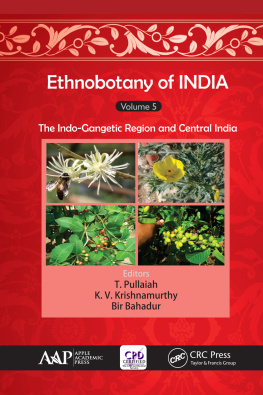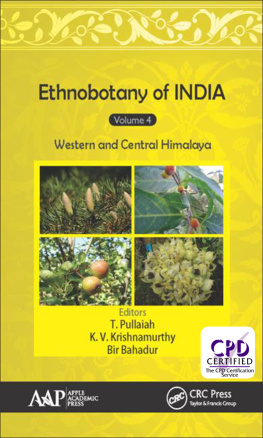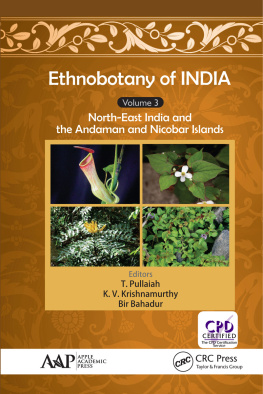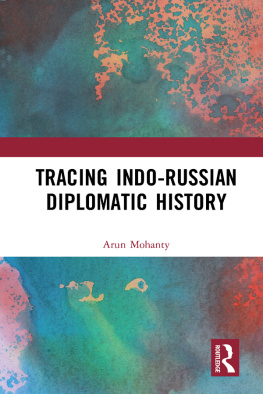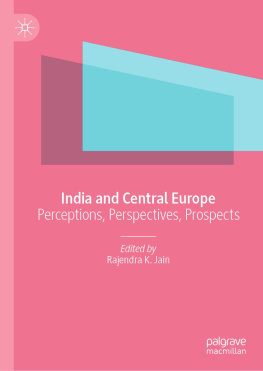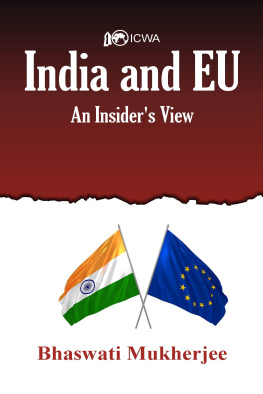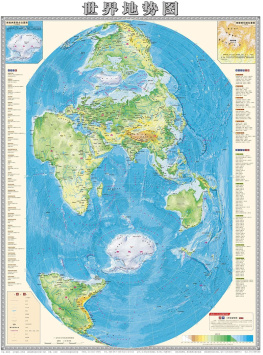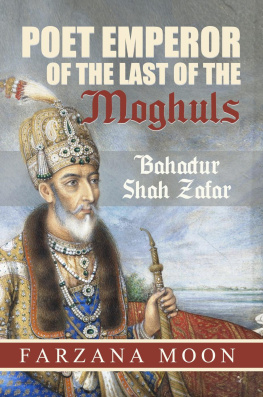Bahadur Bir - Ethnobotany of India, Volume 5 The Indo-Gangetic Region and Central India
Here you can read online Bahadur Bir - Ethnobotany of India, Volume 5 The Indo-Gangetic Region and Central India full text of the book (entire story) in english for free. Download pdf and epub, get meaning, cover and reviews about this ebook. City: India, year: 2017;2018, publisher: CRC Press LLC;Apple Academic Press, genre: Politics. Description of the work, (preface) as well as reviews are available. Best literature library LitArk.com created for fans of good reading and offers a wide selection of genres:
Romance novel
Science fiction
Adventure
Detective
Science
History
Home and family
Prose
Art
Politics
Computer
Non-fiction
Religion
Business
Children
Humor
Choose a favorite category and find really read worthwhile books. Enjoy immersion in the world of imagination, feel the emotions of the characters or learn something new for yourself, make an fascinating discovery.
- Book:Ethnobotany of India, Volume 5 The Indo-Gangetic Region and Central India
- Author:
- Publisher:CRC Press LLC;Apple Academic Press
- Genre:
- Year:2017;2018
- City:India
- Rating:5 / 5
- Favourites:Add to favourites
- Your mark:
- 100
- 1
- 2
- 3
- 4
- 5
Ethnobotany of India, Volume 5 The Indo-Gangetic Region and Central India: summary, description and annotation
We offer to read an annotation, description, summary or preface (depends on what the author of the book "Ethnobotany of India, Volume 5 The Indo-Gangetic Region and Central India" wrote himself). If you haven't found the necessary information about the book — write in the comments, we will try to find it.
Bahadur Bir: author's other books
Who wrote Ethnobotany of India, Volume 5 The Indo-Gangetic Region and Central India? Find out the surname, the name of the author of the book and a list of all author's works by series.
Ethnobotany of India, Volume 5 The Indo-Gangetic Region and Central India — read online for free the complete book (whole text) full work
Below is the text of the book, divided by pages. System saving the place of the last page read, allows you to conveniently read the book "Ethnobotany of India, Volume 5 The Indo-Gangetic Region and Central India" online for free, without having to search again every time where you left off. Put a bookmark, and you can go to the page where you finished reading at any time.
Font size:
Interval:
Bookmark:

We wish to express our grateful thanks to all the authors who have contributed their chapters. We thank them for their cooperation and erudition. We also thank several colleagues for their help in many ways and for their suggestions from time to time during the evolution of this volume.
We wish to express our appreciation and help rendered by Ms. Sandra Jones Sickels and her staff at Apple Academic Press. Above all, their professionalism that has made this book a reality is greatly appreciated.
We thank Mr. John Adams, Senior Research Fellow of Prof. K. V. Krishnamurthy for his help in many ways.
We wish to express our grateful thanks to our respective family members for their cooperation.
We hope that this book will help our fellow teachers and researchers who enter the world of the fascinating subject of ethnobotany in India with confidence.
Editors
S. John Adams
R&D - Phytochemistry and Pharmacognosy, Sami labs Ltd, Peenya Industrial Area, Bangalore, India, E-mail:
Bir Bahadur
Department of Botany, Kakatiya University, Warangal-506009, India, E-mail:
S. Noorunnisa Begum
Centre of Repository of Medicinal Resources, School of Conservation of Natural Resources, Foundation for Revitalization of Local Healthand Traditions, 74/2, Jarakabande Kaval, Attur P.O., Via Yelahanka, Bangalore - 560106, India, E-mail:
E. Chamundeswari
Department of Botany, Kakatiya University, Warangal - 560009, Telangana, India
Baljot Kaur
Stri Roga & Prasuti Tantra (Gyne & Obs), SKSS Ayurvedic Medical College, Sarabha, Ludhiana, Punjab, India, E-mail:
K. V. Krishnamurthy
R&D - Phytochemistry and Pharmacognosy, Sami Labs Ltd, Peenya Industrial Area, Bangalore-560058, India, E-mail:
K. Ravi Kumar
Centre of Repository of Medicinal Resources, School of Conservation of Natural Resources, Foundation for Revitalization of Local Healthand Traditions, 74/2, Jarakabande Kaval, Attur P.O., Via Yelahanka, Bangalore - 560106, India, E-mail:
Suman K. Mandal
Department of Botany, Visva-Bharati University, Santiniketan-731235, West Bengal
R. Ratna Manjula
Department of Botany, Andhra University, Visakhapatnam - 530003, India
K. Sri Rama Murthy
R&D Center for Conservation Biology and Plant Biotechnology, Shivashakti Biotechnologies Limited, S. R. Nagar, Hyderabad - 500038, Telangana, India, E-mail:
Gorti Bala Pratyusha
Department of Genetics, Shadan P. G. Institute of Biosciences for Women, Osmania University, Hyderabad - 500004, Telangana, India, E-mail:
T. Pullaiah
Department of Botany, Sri Krishnadevaraya University, Anantapur-515003, Andhra Pradesh, India, E-mail:
Chowdhury Habibur Rahaman
Department of Botany, Visva-Bharati University, Santiniketan - 731235, West Bengal, India, E-mail:
Maddi Ramaiah
Department of Pharmacognosy, Hindu College of Pharmacy, Guntur - 522002, A.P., India, E-mail:
J. Koteswara Rao
Department of Botany, Andhra University, Visakhapatnam - 530003, India
Sudip Ray
Department of Botany, PMB Gujarati Science College, Indore - 452001, Madhya Pradesh, India, E-mail:
T. V. V. Seetharami Reddi
Department of Botany, Andhra University, Visakhapatnam - 530003, India, E-mail:
Manickam Tamil Selvi
Value Added Corporate Services Pvt. Ltd, Chennai - 600090, Tamil Nadu, India
R. L. S. Sikarwar
Arogyadham (J.R.D. Tata Foundation for Research in Ayurveda and Yoga Sciences), Deendayal Research Institute, Chitrakoot, Dist. Satna (M.P) - 485334, India, E-mail:
Ankanagari Srinivas
Department of Genetics, Osmania University, Hyderabad - 500007, Telangana, India, E-mail:
J. Suneetha
Department of Botany, Andhra University, Visakhapatnam - 530003, India
D. K. Ved
Centre of Repository of Medicinal Resources, School of Conservation of Natural Resources, Foundation for Revitalization of Local Healthand Traditions, 74/2, Jarakabande Kaval, Attur PO., Via Yelahanka, Bangalore - 560106, India, E-mail:
Vijay V. Wagh
Plant Diversity, Systematics and Herbarium Division, CSIR - National Botanical Research Institute, Rana Pratap Marg, Lucknow - 226001, Uttar Pradesh, India, E-mail:
1 R&D Phytochemistry and Pharmacognosy, Sami Labs Ltd, Peenya Industrial Area, Bangalore, India, E-mail:
2 Department of Botany, Sri Krishnadevaraya University, Anantapur 515003, India, E-mail:
3 Department of Botany, Kakatiya University, Warangal 505009, India, E-mail:
The present chapter introduces the articles that form the content of volume 5 of Ethnobotany of India. This volume relates to the Indo-Gangetic plains which form a vast area in northern India. This study region and its physical features, land use patterns, vegetations and floristics are introduced first. This is followed by an introduction to ethnic diversity of the region, Indus valley civilization, one of the oldest civilizations of the world that saw the emergence of great traditional knowledge on plants and utilitarian traditional knowledge (on food, medicine, veterinary medicine and other useful items). These are followed by introductions to chapters on plant contraceptives, Ethnomedicinal plants of skin diseases, and liver diseases as well as on the ethnobotany of neem. The importance of ethnogenomics and the developments that happened during the post -genomic period on ethnobotanical research is also introduced. Finally the future aspects that need to be taken on Indian ethnobotany are also discussed.
The Himalayas girdling the northern border, the flat Indo-Gangetic plains in the middle, the peninsular India along with its hills and plateaus in the south and the narrow coastal plains forming the seaboard are the major provinces of India (Valdiya, 2010). The Indo-Gangetic plains are separated from the Himalayas by the Siwalik or outer Himalayas and are one of the worlds largest alluvial plains. These plains were built in the Holocene times by the Brahmaputra, Ganges and Indus river systems and their tributaries and extend 3,200 km from the southern limit of Brahmaputra-Ganges delta in the east to the terminus of the Indus delta and the Rann of Kutch in the west. The width of the plains varies from 90 km (in Assam) to 550 km (in Punjab).
In the Indus basin the alluvial gives way southeastwards to the Thar Desert (with several sand dunes) that extends in Rajasthan and adjoining Sindh region. The desert region is believed to represent the basin of the legendary Saraswati River that got lost in the Later Holocene period. It is now represented by the dry flood water-channels of the Ghaggar-Hakra-Nara River. The average elevation of the Indo-Gangetic plains range from 150 m to 290 m. The underground extension of the Aravallis towards Haridwar forms the boundary between Indus and Ganga plains. The Indus plain is predominantly the Khaddar expanse that is known as Chung in the Punjab. This plain is fringed in the west by Piedmont Belt, which is 16-24 km wide. Within the Indus plain the rivers and streams are confined the Luni river forms an alluvial plain in the Arid part of long and 300 km wide, on the foot of Aravalli hills, there are many saline lakes like Sambhar, Dadwana, Degana, Lunkaransar, etc. (which turn into water bodies during rainy days) (Valdiya, 2010).
The Ganges plain exhibits little variation in landscape or relief for several hundred kilometers but may be relieved in some areas by bluffs, leaves and abandoned channels, oxbow lakes and ravines, with occasional formations of Chars (Uplands) and Bhils or Jheels (Marshes and lakes). The main Ganges Domain is in Uttar Pradesh with two distinct physiographic regions: Older Alluvium comprising the Banda, Varanasi and Bhangar units of Coarse sedimentary deposits and newer Alluvium comprising the Khaddar, Bhaur and the Bhabhar units of gravelly sediments. The fans of rivers like Ganga, Sharada, Gandak and Kosi continue to grow in size and thickness (Valdiya, 2010).
Font size:
Interval:
Bookmark:
Similar books «Ethnobotany of India, Volume 5 The Indo-Gangetic Region and Central India»
Look at similar books to Ethnobotany of India, Volume 5 The Indo-Gangetic Region and Central India. We have selected literature similar in name and meaning in the hope of providing readers with more options to find new, interesting, not yet read works.
Discussion, reviews of the book Ethnobotany of India, Volume 5 The Indo-Gangetic Region and Central India and just readers' own opinions. Leave your comments, write what you think about the work, its meaning or the main characters. Specify what exactly you liked and what you didn't like, and why you think so.

